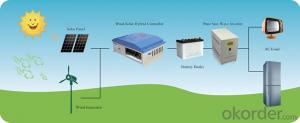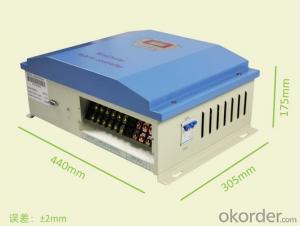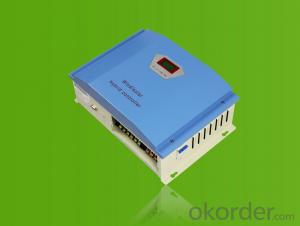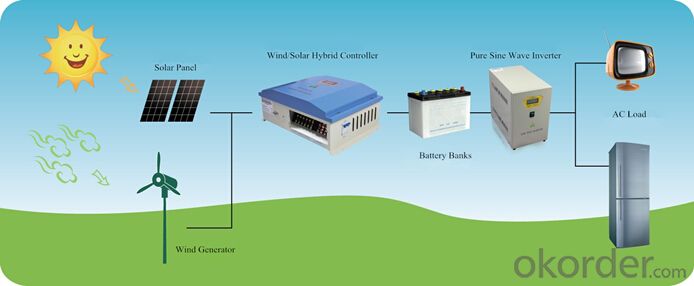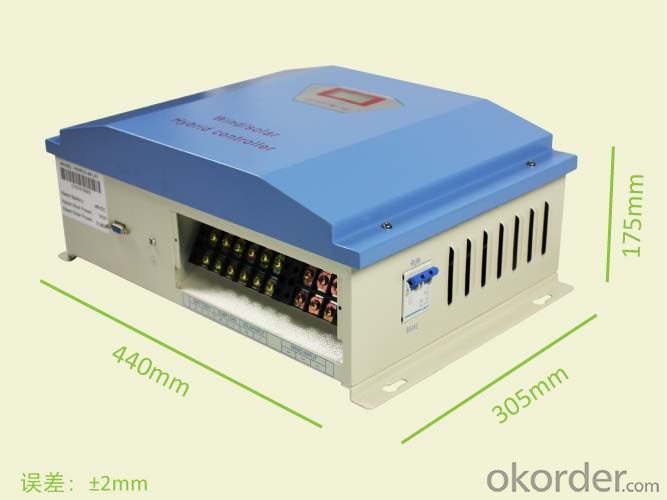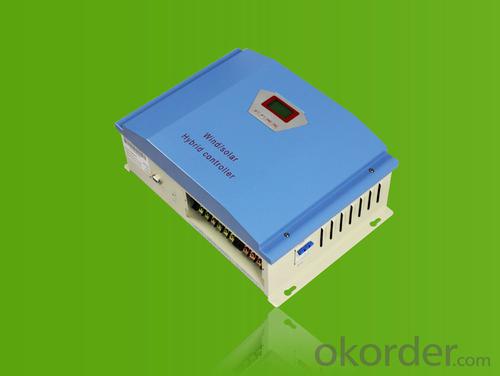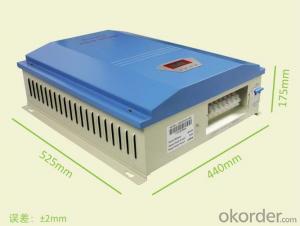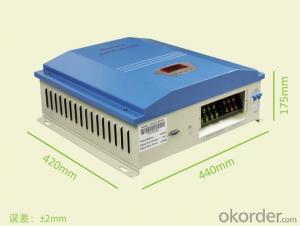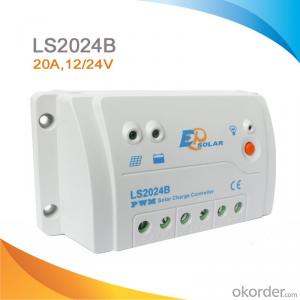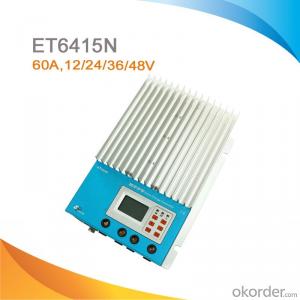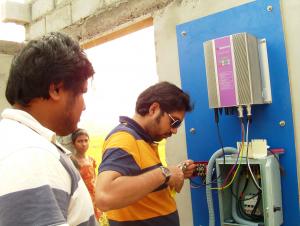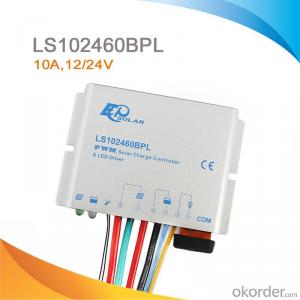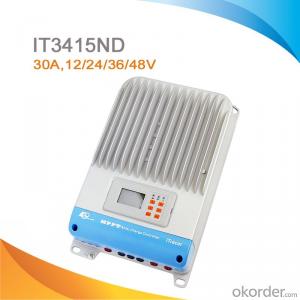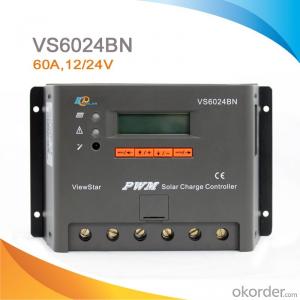Wind Solar Hybrid Controller 20KW PWM Stepless Unload Mode
- Loading Port:
- Shanghai
- Payment Terms:
- TT or LC
- Min Order Qty:
- 1 unit
- Supply Capability:
- 5000 unit/month
OKorder Service Pledge
OKorder Financial Service
You Might Also Like
I. PRODUCT INTRODUCTION
The wind/solar hybrid controller is control device which can control wind turbine and solar panel at the same time and transform wind and solar energy into electricity then store to the battery bank. Wind/solar hybrid controller is the most important part in off-grid system, whose performance has much effect on life expectancy and operational stability of the whole system, especially the battery expectancy. Or battery service life will be shortened by over-charge or over-discharge.
II. PERFORMANCE FEATURES
Superior military-grade components to ensure the product stability.
Perfect protection function, thus the system has higher reliability.
Check and set all operation parameters as requirement from LCD display.
Voltage limiting and current-limiting charge mode ensures battery in the best charging status.
PWM stepless unload mode, which burn the excess power into dump load, making the battery charging in best status.
III. APPLICATION AREAS
Stand alone wind/solar hybrid power station; Stand alone domestic household wind/solar hybrid power system.
Mobile communication base stations, expressway and other non-residential regions.
Coastal islands, remote mountainous, border posts for regions shortage of or without electricity.
Government demonstration projects, landscape lighting project.
IV. 20KW TECHNICAL PARAMETERS
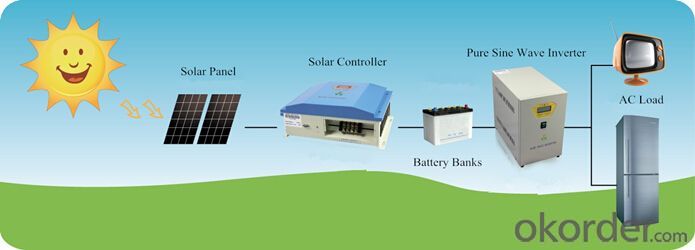
- Q: How does a solar controller handle battery capacity testing?
- A solar controller handles battery capacity testing by monitoring the voltage and current flow in and out of the battery. It typically measures the battery's voltage at regular intervals and calculates the state of charge (SOC) based on predefined voltage thresholds. By analyzing the SOC over time, the solar controller can estimate the battery's capacity and determine if it needs to be charged or discharged for optimal performance.
- Q: Can a solar controller be used with solar-powered indoor manufacturing systems?
- Yes, a solar controller can be used with solar-powered indoor manufacturing systems. A solar controller regulates the flow of electricity from solar panels to batteries or other energy storage devices, ensuring that the system operates efficiently and safely. Whether the manufacturing system is indoor or outdoor, a solar controller is essential to manage the solar power generated by the system and optimize its usage.
- Q: Can a solar controller handle different battery types (e.g., lead-acid, lithium)?
- Yes, a solar controller can handle different battery types such as lead-acid and lithium. Many modern solar controllers are designed to be compatible with various battery chemistries and provide appropriate charging profiles based on the specific battery type. This ensures optimal charging and protection for the batteries, regardless of whether they are lead-acid or lithium.
- Q: Can a solar controller be used with a 48V battery bank?
- A 48V battery bank can indeed be used in conjunction with a solar controller. The main role of the solar controller is to regulate the electricity flow from the solar panels to the battery bank. Its primary functions are to efficiently charge the batteries and safeguard them against both overcharging and discharging. The majority of solar controllers are equipped with a wide voltage range capability, making them compatible with 48V battery banks. Therefore, as long as the solar controller is designed to handle the battery bank's voltage, it can effectively operate within a 48V system. Before installation, it is crucial to verify that the solar controller is compatible with the specific voltage of the battery bank in order to prevent any potential compatibility issues.
- Q: How do I ensure proper grounding of a solar controller system?
- To ensure proper grounding of a solar controller system, there are a few key steps you should follow. First, make sure to connect the grounding wire from the solar controller to a grounding electrode, such as a grounding rod or a metal water pipe. This will provide a direct path for any electrical faults to dissipate safely into the ground. Additionally, ensure that the grounding wire is properly sized according to the manufacturer's recommendations. It is also important to regularly inspect the grounding system for any signs of damage or corrosion and fix them promptly. Lastly, consult local electrical codes and regulations to ensure compliance with specific grounding requirements in your area.
- Q: How does a solar controller prevent undercharging of batteries?
- A solar controller prevents undercharging of batteries by monitoring the voltage and current from the solar panels and regulating the charging process. It ensures that the batteries receive the optimal amount of charge by adjusting the voltage and current to match the specific requirements of the battery. Additionally, it prevents over-discharging by disconnecting the battery from the solar panels when its voltage drops below a certain level, thus preserving the battery's lifespan.
- Q: Can a solar controller be used with a solar-powered chicken coop?
- Yes, a solar controller can be used with a solar-powered chicken coop. A solar controller helps regulate the charging and discharging of batteries in a solar system, ensuring optimal performance and preventing overcharging. In a solar-powered chicken coop, the solar controller can be used to manage the power generated by the solar panels and store it in batteries for use during cloudy days or at night, providing a reliable source of electricity for the coop's lighting, heating, or other electrical needs.
- Q: How does a solar controller handle shading on the solar panels?
- A solar controller is designed to handle shading on solar panels in an efficient and effective manner. When a solar panel is shaded, it can significantly reduce the overall energy output of the entire solar system. To mitigate the impact of shading, solar controllers use a technique called Maximum Power Point Tracking (MPPT). MPPT is a technology that ensures the solar panels operate at their highest possible power output, even when some parts of the panel are shaded. Solar controllers constantly monitor the voltage and current of the solar panels to determine the optimal operating point. They adjust the load impedance to match the panel's impedance and maximize the power transfer. This way, even if a portion of the solar panel is shaded, the unaffected sections can still produce power at their maximum potential. Additionally, some advanced solar controllers have built-in algorithms that can detect shading and dynamically reconfigure the panel's electrical connections. This reconfiguration allows the shaded cells to be bypassed or isolated, ensuring that the energy production is not negatively impacted by the shaded area. Overall, a solar controller plays a crucial role in handling shading on solar panels by employing MPPT technology and advanced algorithms. This ensures that the solar system operates at its highest efficiency, maximizing energy production even in partially shaded conditions.
- Q: Solar controller red light flashing
- Installation of the controller should pay attention to: 1, waterproof; some of the controller on the market is not easy to produce waterproof, easy to penetrate the water vapor in the poles, resulting in short circuit and other issues; 2, pay attention to the controller and system rationality, 3, the main function of the controller is to protect the battery, must pay attention to.
- Q: Can a solar controller be used with solar panel ground fault detection systems?
- Yes, a solar controller can be used with solar panel ground fault detection systems. A solar controller is responsible for regulating the voltage and current flow from the solar panels to the battery or grid. It ensures that the solar panels are operating at their maximum efficiency and keeps track of the charging process. On the other hand, a ground fault detection system is designed to detect any ground faults or leakage currents in the solar panel system. It monitors the electrical connections and detects any abnormalities that may pose a safety risk. In most cases, the solar controller and ground fault detection system work independently of each other. The solar controller focuses on optimizing the energy production and storage, while the ground fault detection system focuses on ensuring the safety of the system. However, it is possible to integrate the two systems together. Some advanced solar controllers may have built-in ground fault detection capabilities or can be connected to an external ground fault detection system. This integration allows for more comprehensive monitoring and protection of the solar panel system. In conclusion, while a solar controller and a ground fault detection system serve different purposes, they can be used together to enhance the overall performance and safety of a solar panel system.
Send your message to us
Wind Solar Hybrid Controller 20KW PWM Stepless Unload Mode
- Loading Port:
- Shanghai
- Payment Terms:
- TT or LC
- Min Order Qty:
- 1 unit
- Supply Capability:
- 5000 unit/month
OKorder Service Pledge
OKorder Financial Service
Similar products
Hot products
Hot Searches
Related keywords
